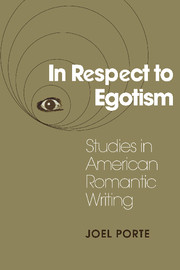Book contents
- Frontmatter
- Contents
- Preface
- Acknowledgments
- In Respect to Egotism
- Introduction: Writing, Reading, Romanticism
- 1 “Where … Is This Singular Career to Terminate?”: Bewildered Pilgrims in Early American Fiction
- 2 “Where There Is No Vision, the People Perish.…”: Prophets and Pariahs in the Forest of the New World
- 3 Poe: Romantic Center, Critical Margin
- 4 Emerson: Experiments in Self-Creation
- 5 Hawthorne: “The Obscurest Man of Letters in America”
- 6 Thoreau's Self-Perpetuating Artifacts
- 7 Melville: Romantic Cock-and-Bull; or, The Great Art of Telling the Truth
- 8 Douglass and Stowe: Scriptures of the Redeemed Self
- 9 Whitman: “Take Me as I Am or Not at All.…”
- Interchapter: Walt and Emily
- 10 Dickinson's “Celestial Vail”: Snowbound in Self-Consciousness
- Notes
- Index
- CAMBRIDGE STUDIES IN AMERICAN LITERATURE AND CULTURE
2 - “Where There Is No Vision, the People Perish.…”: Prophets and Pariahs in the Forest of the New World
Published online by Cambridge University Press: 24 March 2010
- Frontmatter
- Contents
- Preface
- Acknowledgments
- In Respect to Egotism
- Introduction: Writing, Reading, Romanticism
- 1 “Where … Is This Singular Career to Terminate?”: Bewildered Pilgrims in Early American Fiction
- 2 “Where There Is No Vision, the People Perish.…”: Prophets and Pariahs in the Forest of the New World
- 3 Poe: Romantic Center, Critical Margin
- 4 Emerson: Experiments in Self-Creation
- 5 Hawthorne: “The Obscurest Man of Letters in America”
- 6 Thoreau's Self-Perpetuating Artifacts
- 7 Melville: Romantic Cock-and-Bull; or, The Great Art of Telling the Truth
- 8 Douglass and Stowe: Scriptures of the Redeemed Self
- 9 Whitman: “Take Me as I Am or Not at All.…”
- Interchapter: Walt and Emily
- 10 Dickinson's “Celestial Vail”: Snowbound in Self-Consciousness
- Notes
- Index
- CAMBRIDGE STUDIES IN AMERICAN LITERATURE AND CULTURE
Summary
When James Fenimore Cooper's daughter Susan looked back to the beginning of her father's career as an American romancer, she pointed to the publication of The Last of the Mohicans in 1826 as having produced “quite a startling effect” in Europe – especially in Europe – as well as in America because, she claimed, “the freshness of the subject” added “greatly to the vivid interest of the narrative.” The “subject” to which she was principally alluding was the American Indian, the one truly original subject available to American writers, particularly vis-a-vis European fiction. The romance of the New World could hardly be said to exist without the imaginative exploitation of the country's aborigines, and another notable American romancer, Hawthorne, would note ruefully that his own abhorrence of “an Indian story” had shut him out “from the most peculiar field of American fiction.” No writer, he went on, “can be more secure of a permanent place in our literature, than the biographer of the Indian chiefs.” Susan Cooper was making her claim for the uniqueness of her father's work precisely on this point, and she was therefore obliged to deal with the prior claim of Brockden Brown. “As yet,” she notes, “there had been but one American work of the imagination in which the red man was introduced with any prominence: ‘Edgar Huntley,’ by Brockden Brown, a writer of undoubted talent, but scarcely known in England” – an odd mistake, but we observe that she was simply trying to stake out her father's territory as securely as possible and was therefore brushing Brown aside.
- Type
- Chapter
- Information
- In Respect to EgotismStudies in American Romantic Writing, pp. 54 - 74Publisher: Cambridge University PressPrint publication year: 1991



